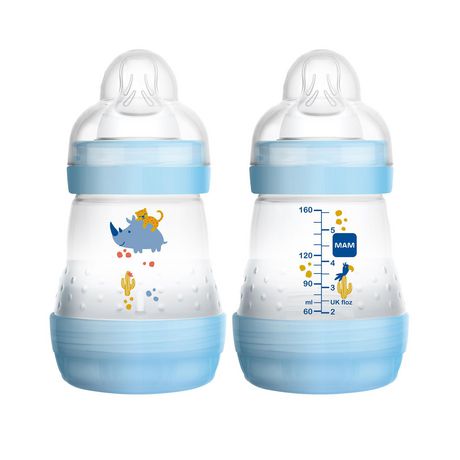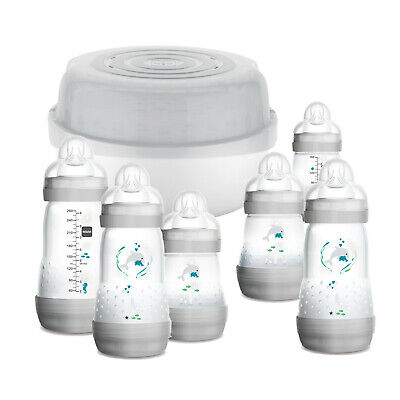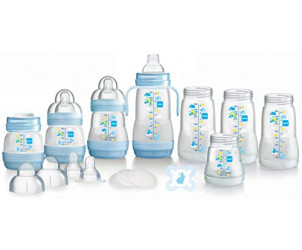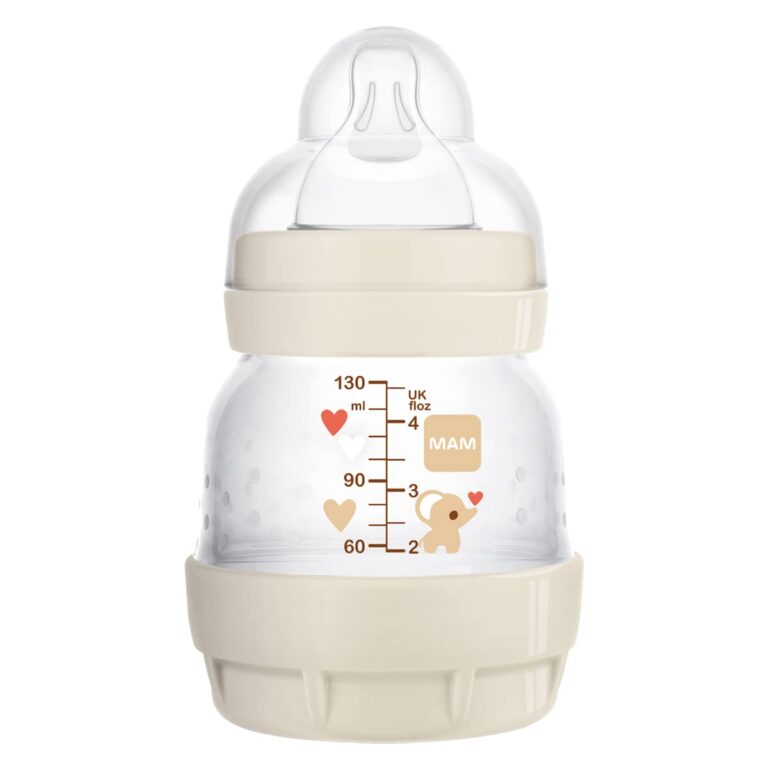When it comes to feeding your precious little one, ensuring their safety and health is of utmost importance. Sterilizing baby bottles is an essential step in preventing the growth of harmful bacteria and keeping your baby’s bottles clean and hygienic. One commonly used method of sterilization is using a microwave. In this blog post, we will explore how long it takes to sterilize MAM bottles in the microwave.
Generally, It takes 3 to 4 minutes to sterilize Mam Bottles in Microwave, but it depends on watts of your microwave.
- For microwaves with a wattage of 500-900W, the recommended sterilization time is 3 minutes.
- For microwaves with a wattage of 900-1100W, the recommended sterilization time is 4
Read the article to get a clear idea of how to use the microwave to sterilize Mam Bottles.
The Importance of Sterilizing Baby Bottles
Babies have fragile immune systems, making them more susceptible to infections and illnesses. Sterilizing baby bottles helps eliminate harmful bacteria, viruses, and other germs that may be present, reducing the risk of your baby falling ill. By ensuring that the bottles your baby uses are properly sterilized, you can provide them with a safe feeding experience and peace of mind for yourself.
Methods of Sterilizing Baby Bottles
There are several methods available for sterilizing baby bottles, including boiling, using sterilizing solutions, and microwave sterilization. Microwave sterilization is a convenient and time-efficient option for busy parents.
To sterilize MAM bottles in the microwave, follow these simple steps:
- Disassemble the bottle, separating the bottle, nipple, and other components.
- Place the bottles and accessories in a microwave-safe sterilizing container or a microwave sterilizer specifically designed for baby bottles.
- Add the recommended amount of water to the sterilizing container as per the manufacturer’s instructions.
- Cover the sterilizing container and place it in the microwave.
- Set the microwave to the appropriate power level and duration as specified in the MAM bottle’s instructions or the sterilizing container manufacturer’s guidelines.
- Start the microwave and allow the sterilization process to complete.
- Carefully remove the sterilizing container from the microwave, using oven mitts or heat-resistant gloves. Take caution as the container and its contents will be hot.
- Allow the bottles and accessories to cool before handling.
- Thoroughly rinse the bottles and accessories with boiled or filtered water before assembling them for use.
It is essential to note that the sterilization time in the microwave may vary depending on the wattage of your microwave. The manufacturer’s instructions for the MAM bottle or the sterilizing container should provide specific guidelines for the duration and power level.
Overall, microwave sterilization can be a quick and effective method to ensure the safety and cleanliness of your baby’s MAM bottles. By following the proper guidelines and instructions, you can provide your little one with bottles that are free from harmful bacteria and germs, keeping them healthy and happy.
Microwave Sterilization
Microwave sterilization is a convenient and efficient method for sterilizing baby bottles, including Mam bottles. It allows parents to quickly and effectively eliminate harmful bacteria and ensure their baby’s feeding equipment is safe to use. In this article, we will discuss how microwave sterilization works and provide step-by-step instructions on how to sterilize Mam bottles in the microwave.
How Does Microwave Sterilization Work?
Microwave sterilization works by using the heat generated by the microwaves to kill bacteria and other microorganisms on the surfaces of the baby bottles. The microwave emits electromagnetic waves that cause the water molecules inside the bottles to vibrate rapidly, creating heat. This heat kills the bacteria, effectively sterilizing the bottles.
Steps for Microwave Sterilization
To sterilize Mam bottles in the microwave, follow these steps:
Step 1: Clean the bottles thoroughly with warm soapy water or in a dishwasher.
Step 2: Pour a sufficient amount of water into the bottles to cover all surfaces.
Step 3: Place the bottles, nipples, and caps in a microwave-safe container.
Step 4: Put the container in the microwave, making sure it is stable and secure.
Step 5: Set the microwave to high power and heat the bottles for the recommended time. Refer to the Mam bottle instructions or consult the manufacturer’s guidelines for microwave sterilization times. Generally, it takes around 2-6 minutes to sterilize Mam bottles in the microwave.
Step 6: Carefully remove the container from the microwave using oven mitts or a towel, as it will be hot.
Step 7: Let the bottles cool down before handling them. The bottles will be extremely hot immediately after sterilization.
Step 8: Once the bottles have cooled down, remove them from the container and assemble with clean hands or using sterilized tongs.
It is important to note that different microwaves may vary in power, so it is crucial to follow the specific instructions provided by the bottle manufacturer. Additionally, ensure that the container used for sterilization is microwave-safe and that it fits properly within the microwave.
Microwave sterilization offers a quick and efficient way to sanitize Mam bottles and other feeding equipment. It is essential to sterilize baby bottles regularly to prevent the spread of harmful bacteria and protect your baby’s health. Always prioritize the safety and hygiene of your baby’s feeding equipment.
Sterilizing MAM Bottles
Why Choose MAM Bottles?
MAM bottles are a popular choice among parents for their quality and innovative design. These bottles are made with high-quality materials that are free from harmful substances like BPA and BPS. They feature a unique self-sterilizing function, making them convenient and easy to use. MAM bottles also come with an ergonomic shape and a soft, skin-like nipple that mimics the feel of breastfeeding. With their advanced features and safety standards, MAM bottles are a trusted brand for both babies and parents.
Recommended Sterilization Time for MAM Bottles in the Microwave
When it comes to sterilizing MAM bottles in the microwave, it is important to follow the manufacturer’s instructions for the correct sterilization time. The self-sterilizing function of MAM bottles allows for quick and efficient sterilization in just a few simple steps.
Here is the recommended sterilization time for MAM bottles in the microwave:
- Fill the MAM bottle with the desired amount of water and assemble it according to the instructions.
- Place the assembled bottle in the microwave along with the lid.
- Set the microwave to the recommended sterilization time based on the wattage of your microwave:
- For microwaves with a wattage of 500-900W, the recommended sterilization time is 3 minutes.
- For microwaves with a wattage of 900-1100W, the recommended sterilization time is 4 minutes.
- Start the microwave and allow it to run for the recommended sterilization time.
- After the sterilization cycle is complete, carefully remove the bottle from the microwave using oven mitts or a towel, as it may be hot.
- Allow the bottle to cool before use and check that the water inside has evaporated to ensure thorough sterilization.
It’s important to note that the recommended sterilization time may vary depending on the wattage of your microwave. It’s always best to refer to the instructions provided by MAM for the most accurate and up-to-date information.
In conclusion, sterilizing MAM bottles in the microwave is a quick and convenient way to ensure the safety and cleanliness of your baby’s feeding equipment. By following the recommended sterilization time and proper instructions, you can maintain the hygiene and quality of MAM bottles for your little one.
Safety Precautions
Handling Hot Bottles in the Microwave
When sterilizing MAM bottles in the microwave, it’s important to take certain safety precautions to ensure the process is effective and safe.
1. Properly clean the bottles: Before sterilizing the bottles, make sure to wash them thoroughly with mild soap and water. This will remove any residual milk or formula, allowing the sterilization process to be more effective.
2. Follow the manufacturer’s instructions: Each microwave sterilization method may have slightly different instructions, so it’s essential to read and follow the instructions provided by MAM. This will help you understand the specific time and power settings recommended for your MAM bottles.
3. Use microwave-safe equipment: Ensure that the bottles and sterilization equipment you use are microwave safe. Look for labels or symbols on the bottles, nipple rings, and lids that indicate they are microwave safe. If in doubt, consult the MAM website or contact their customer support for clarification.
Avoiding Overheating and Melting
The microwave sterilization process can reach high temperatures, so it’s crucial to avoid overheating the bottles to prevent damage or melting.
1. Do not exceed the recommended sterilization time: Follow the recommended sterilization time provided by MAM. Exceeding the recommended time can cause excessive heat, which may melt or deform the bottles or their components.
2. Allow the bottles to cool before handling: After sterilization, let the bottles cool down before removing them from the microwave. The bottles will be hot, and handling them immediately can cause burns or injury.
3. Check for any signs of damage: After sterilizing the bottles, carefully inspect them for any signs of damage, such as warping, discoloration, or melting. If any damage is observed, discard the bottles and replace them with new ones.
It’s important to note that microwaving MAM bottles for sterilization is just one method, and MAM also offers other sterilization options like steam sterilization. The choice of sterilization method is ultimately up to the parents based on their preference and convenience.
Remember, the safety and well-being of your little one should always be the top priority. By following these safety precautions, you can effectively sterilize MAM bottles in the microwave while ensuring the safety of your baby.
Alternative Sterilization Methods
When it comes to sterilizing baby bottles, the most common method used is a steam sterilizer. However, if you don’t have access to a steam sterilizer or prefer alternative methods, there are a few options available. In this section, we will explore two popular alternatives: the boiling water method and chemical sterilizing solutions.
Boiling Water Method
One of the simplest and most cost-effective ways to sterilize baby bottles is by using the boiling water method. Here’s how it works:
- Clean the bottles: Before sterilizing, make sure to clean the bottles thoroughly with warm soapy water.
- Fill a large pot with water: Fill a large pot with enough water to submerge all the bottles and other accessories.
- Place the bottles in the pot: Immerse the bottles in the boiling water, making sure they are fully submerged.
- Boil the water: Bring the water to a rolling boil and let it continue boiling for at least 5 minutes to ensure proper sterilization.
- Remove the bottles: Use tong or kitchen mitts to carefully remove the bottles from the boiling water and place them on a clean towel to dry.
While the boiling water method is effective in killing germs and bacteria, be cautious and follow the manufacturer’s instructions to prevent damage to the bottles.
Chemical Sterilizing Solutions
Chemical sterilizing solutions are another popular alternative for sterilizing baby bottles. These solutions typically contain a disinfectant that kills bacteria and germs. Here’s how to use them:
- Clean the bottles: As with the boiling water method, start by cleaning the bottles with warm soapy water.
- Prepare the solution: Follow the instructions on the sterilizing solution to prepare the proper dilution.
- Submerge the bottles: Place the bottles and other accessories in a container filled with the sterilizing solution, ensuring they are fully submerged.
- Soak for the recommended time: Read the instructions to know how long the bottles need to soak in the solution.
- Rinse the bottles: After the recommended soaking time, thoroughly rinse the bottles with clean water to remove any residual solution.
Chemical sterilizing solutions offer a convenient and effective alternative, but make sure to read and follow the instructions carefully to ensure proper sterilization of the bottles.
Overall, both the boiling water method and chemical sterilizing solutions are effective ways to sterilize baby bottles if you don’t have access to a steam sterilizer. Choose the method that suits your needs and preferences, and always prioritize the safety and cleanliness of your baby’s bottles.
Frequently Asked Questions
Can You Sterilize MAM Bottles in a Dishwasher?
Sterilizing MAM bottles in a dishwasher is possible and can be a convenient option for busy parents. However, it is important to note that not all MAM bottle parts are suitable for dishwasher sterilization. While the bottle itself can typically withstand dishwasher heat, the nipples, caps, and other small parts may not hold up as well. It is recommended to check the manufacturer’s guidelines for specific instructions on dishwasher sterilization for MAM bottles.
How Often Should You Sterilize Baby Bottles?
The frequency of sterilizing baby bottles depends on the age and health of your baby. For newborns and during the first year, it is generally recommended to sterilize bottles regularly, especially when they are used for formula feeding. This is because newborns have developing immune systems and are more susceptible to infections.
It is generally recommended to sterilize baby bottles before first use and then regularly until the baby reaches their first birthday. However, if your baby was born prematurely, if they have a weakened immune system, or if they are receiving any medical treatments, it might be necessary to continue sterilizing bottles beyond the first year.
Here is a helpful table outlining different sterilization methods and their benefits:
| Sterilization Method | Description | Benefits |
|---|---|---|
| Boiling water | Placing bottles and accessories in boiling water for a specific time | Simple, cost-effective method, kills most harmful bacteria |
| Steam sterilization | Using an electric steam sterilizer that steams bottles and accessories | Convenient, efficient, kills most harmful bacteria |
| Microwave sterilization | Using a microwave sterilizer specifically designed for baby bottles | Quick, convenient, kills most harmful bacteria |
| Chemical sterilization | Using sterilizing solutions or tablets to soak bottles and accessories | Suitable for travel, kills most harmful bacteria |
Overall, sterilizing MAM bottles in a dishwasher is possible but requires careful consideration of the individual bottle parts. It is essential to follow the manufacturer’s guidelines and ensure that all parts are suitable for dishwasher sterilization. Remember to sterilize baby bottles regularly, especially during the first year, to maintain optimal hygiene and protect your baby’s health.
Conclusion
Summary of Sterilization Methods for MAM Bottles
When it comes to sterilizing MAM bottles in the microwave, there are a few options to choose from. It is important to note that the exact time required for sterilization may vary depending on the wattage of your microwave. Here is a summary of the different methods and their recommended sterilization times:
- Steam Sterilization: This method involves using a microwave steam sterilizer or a microwave-safe container with a lid filled with water. Place the MAM bottles in the sterilizer, add water, and microwave according to the manufacturer’s instructions. On average, it takes about 4-6 minutes to sterilize MAM bottles using steam sterilization in the microwave.
- Boiling Method: Another way to sterilize MAM bottles is by boiling them in a pot of water. Fill a pot with enough water to submerge the bottles, bring it to a boil, and place the bottles in the boiling water. Boil the bottles for approximately 5-10 minutes, ensuring that they are fully submerged.
- Chemical Sterilization: Chemical sterilization involves using sterilizing tablets or solutions specifically designed for baby bottles. Follow the instructions on the packaging for the appropriate concentration and contact time. After soaking the bottles in the sterilizing solution, rinse them thoroughly with water before use.
It is important to always follow the manufacturer’s guidelines for sterilizing MAM bottles, as they may provide specific instructions based on the material and design of the bottles.
Importance of Proper Sterilization for Baby’s Health
Proper sterilization of baby bottles, including MAM bottles, is crucial for maintaining the health and safety of your baby. Sterilization helps eliminate harmful bacteria, viruses, and other pathogens that may be present on the bottles. Infants have a developing immune system, and their bodies are more susceptible to infections.
By sterilizing MAM bottles, you can reduce the risk of your baby falling ill due to contaminated bottles. It is especially important to sterilize bottles before their first use and whenever there are signs of visible dirt or residue. Regular sterilization also helps prevent the buildup of harmful bacteria that can thrive in leftover milk or formula.
In conclusion, properly sterilizing MAM bottles is essential for ensuring the health and safety of your baby. Whether you choose to sterilize them using a microwave steam sterilizer, boiling method, or chemical sterilization, it is crucial to follow the recommended sterilization times and guidelines. This will give you peace of mind knowing that your baby’s bottles are clean and free from harmful bacteria.




